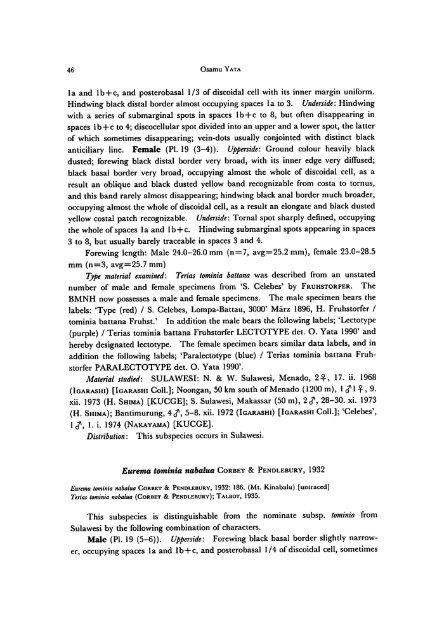A Revision of the Old World Species (Lepidoptera, Pieridae)
A Revision of the Old World Species (Lepidoptera, Pieridae)
A Revision of the Old World Species (Lepidoptera, Pieridae)
Create successful ePaper yourself
Turn your PDF publications into a flip-book with our unique Google optimized e-Paper software.
46 Osamu Yata<br />
la and lb+c, and posterobasal 1/3 <strong>of</strong> discoidal cell with its inner margin uniform.<br />
Hindwing blackdistal border almost occupying spaces la to 3. Underside: Hindwing<br />
with a series <strong>of</strong> submarginal spots in spaces lb+c to 8, but <strong>of</strong>ten disappearing in<br />
spaces lb+c to 4; discocellular spot divided into an upper and a lower spot, <strong>the</strong> latter<br />
<strong>of</strong> which sometimes disappearing; vein-dots usually conjointed with distinct black<br />
anticiliary line. Female (PI. 19 (3-4)). Upperside: Ground colour heavily black<br />
dusted; forewing black distal border very broad, with its inner edge very diffused;<br />
black basal border very broad, occupying almost <strong>the</strong> whole <strong>of</strong> discoidal cell, as a<br />
result an oblique and black dusted yellow band recognizable from costa to tornus,<br />
and this band rarely almost disappearing; hindwing blackanal border much broader,<br />
occupying almost <strong>the</strong> whole <strong>of</strong>discoidal cell, as a result an elongate and black dusted<br />
yellow costal patch recognizable. Underside: Tornal spot sharply defined, occupying<br />
<strong>the</strong> whole <strong>of</strong> spaces la and lb+c. Hindwing submarginal spots appearing in spaces<br />
3 to 8, but usually barely traceable in spaces 3 and 4.<br />
Forewing length: Male 24.0-26.0 mm (n= 7, avg=25.2 mm), female 23.0-28.5<br />
mm (n=3, avg=25.7 mm)<br />
Type material examined: Terias tominia battana was described from an unstated<br />
number <strong>of</strong> male and female specimens from 'S. Celebes' by Fruhstorfer. The<br />
BMNH now possesses a male and female specimens. The male specimen bears <strong>the</strong><br />
labels: 'Type (red) / S. Celebes, Lompa-Battau, 3000' Marz 1896, H. Fruhstorfer /<br />
tominia battana Fruhst.' In addition <strong>the</strong> male bears <strong>the</strong> following labels; 'Lectotype<br />
(purple) / Terias tominia battana Fruhstorfer LECTOTYPE det. O. Yata 1990' and<br />
hereby designated lectotype. The female specimen bears similar data labels, and in<br />
addition <strong>the</strong> following labels; 'Paralectotype (blue) / Terias tominia battana Fruh<br />
storfer PARALECTOTYPE det. O. Yata 1990'.<br />
Material studied: SULAWESI: N. & W. Sulawesi, Menado, 2 + , 17. ii. 1968<br />
(Igarashi) [Igarashi Coll.]; Noongan, 50 km south <strong>of</strong>Menado (1200 m), 1f\ +, 9.<br />
xii. 1973 (H. Shima) [KUCGE]; S. Sulawesi, Makassar (50m), 2f, 28-30. xi. 1973<br />
(H. Shima); Bantimurung, 4f, 5-8. xii. 1972 (Igarashi) [Igarashi Coll.]; 'Celebes',<br />
If, 1. i. 1974 (Nakayama) [KUCGE].<br />
Distribution: This subspecies occurs in Sulawesi.<br />
Eurema tominia nabalua Corbet & Pendlebury, 1932<br />
Eurema tominia nabalua Corbet & Pendlebury, 1932: 186. (Mt. Kinabalu) [untraced]<br />
Terias tominia nabalua (Corbet & Pendlebury); Talbot, 1935.<br />
This subspecies is distinguishable from <strong>the</strong> nominate subsp. tominia from<br />
Sulawesi by <strong>the</strong> following combination <strong>of</strong> characters.<br />
Male (PI. 19 (5-6)). Upperside: Forewing black basal border slightly narrow<br />
er, occupying spaces la and lb+c, and posterobasal 1/4<strong>of</strong>discoidal cell, sometimes
















